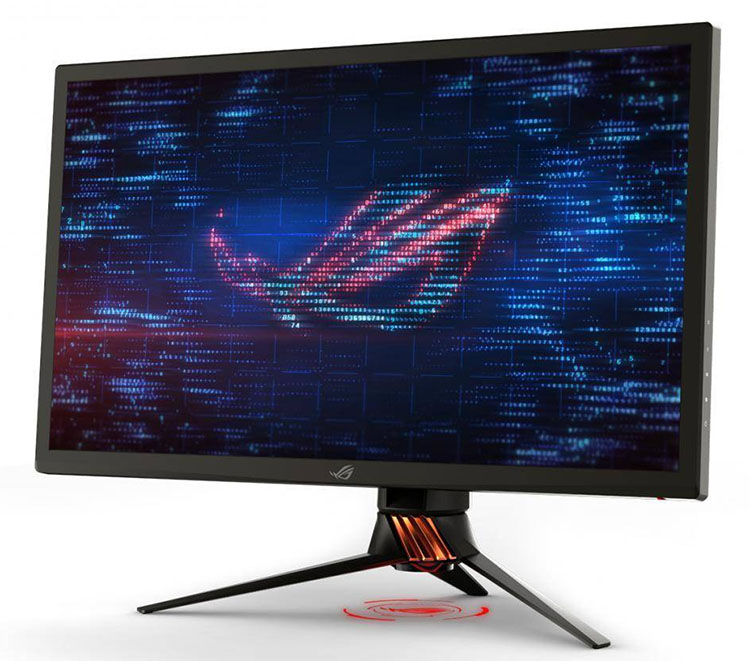Tom's Hardware Verdict
Aside from cost, the Asus ROG Swift PG27UQ has no flaws of consequence. It’s extremely capable for gaming, video, color-critical work and general tasks. And once you’ve experienced games at Ultra HD resolution and 144Hz, it’s hard to imagine playing any other way.
Pros
- +
Stunning image
- +
144Hz in Ultra HD
- +
Amazing SDR and HDR contrast
- +
Over 90 percent DCI-P3 coverage
- +
G-Sync
- +
Build quality, styling
Cons
- -
Expensive
Why you can trust Tom's Hardware
Features & Specifications
Editor's note, 4/17/20:
We originally shared our Asus ROG Swift PG27UQ review testing back in October 19 , 2018. Despite that, the monitor still sits proudly on our Best 4K Gaming Monitors page and is even among the best HDR monitors available today. With an impressive refresh rate, especially at this resolution, and advanced backlight technology, the monitor is still a worthy contender over a year after release. When we reviewed this monitor in 2018 it was $2,000; currently it's selling for $1,300. That affects any value claims made in our original review below.
Original review, 10/18/2020:
Ask 10 users what constitutes the ultimate gaming monitor and you’ll likely get 10 different answers. A few common threads will emerge though. There can never be too much resolution, and there’s no such thing as a refresh rate that’s too high.
We have reviewed many Ultra HD gaming displays, but none have been able to deliver frame rates past 60Hz – until now. Asus’ new ROG Swift PG27 is a 27-inch IPS panel with a 3840 x 2160 resolution, 144Hz refresh rate with overclock, G-Sync, HDR10, DCI-P3 color and true 1,000-nit brightness capability.
We’ll lay it all out right up front. This monitor will reduce your net worth by $2,000. But after spending many hours testing and gaming, we think it’s worth every penny.
Asus ROG Swift PG27UQ Specifications
| Panel Type & Backlight | IPS / W-LED, 384-zone backlight, full array w/ local dimming |
| Screen Size & Aspect Ratio | 27 inches / 16:9 |
| Max Resolution & Refresh | 3840x2160 @ 120Hz; 144Hz w/overclock; Density: 163 ppi |
| Native Color Depth & Gamut | 10-bit (8-bit+FRC) / DCI-P3, HDR10, DisplayHDR 1000 |
| Response Time (GTG) | 4ms |
| Brightness | SDR - 600 nits; HDR - 1,000 nits |
| Contrast | SDR - 1,000:1; HDR - 50,000:1 |
| Speakers | ✗ |
| Video Inputs | 1x DisplayPort 1.4; 1x HDMI 2.0 |
| Audio | 3.5mm headphone output |
| USB | v3.0: 1 x up, 2 x down |
| Power Consumption | 54.2w, brightness @ 200 nits |
| Panel DimensionsWxHxD w/base | 25 x 17.2-21.9 x 9.5 inches / 634 x 437-557 x 268mm |
| Panel Thickness | 3.7 inches / 94mm |
| Bezel Width | Top & Bottom - 0.8 inch / 20mm; Sides - .6 inch / 16mm |
| Weight | 20.2 pounds / 9.2kg |
| Warranty | 3 years |
If you’ve gotten over the sticker shock long enough to read the specs table, then you can see why the PG27UQ is so expensive. It’s only the second HDR screen we’ve seen with a full-array local dimming (FALD) backlight. Like the Dell UP2718Q, it sports 384 independently addressable zones and can hit that magic 1,000-nit brightness level. It also features over 90 percent of the DCI-P3 color space thanks to a quantum-dot film and will run at 144Hz if you engage overclock. There’s a caveat there that we’ll explain in a moment, but the panel’s native refresh rate is 120Hz--not too shabby.
To properly drive this display, you’ll need a GeForce GTX 1080 Ti graphics card and the latest drivers to enable not only the fast refresh but HDR10 support. You’ll also need the Windows 10 update from October 2017 to enable HDR. Better yet, get the April 2018 update to add an HDR brightness slider to the Control Panel. This is the first screen we’ve seen that utilizes the bandwidth capabilities of DisplayPort 1.4. Of course, G-Sync is the tear-eliminating tech of choice and surprisingly, there is no ULMB (ultra low motion blur). The panel will also accept 10-bit signals though its native bit-depth is still 8-bits with Frame Rate Conversion (FRC).
Get Tom's Hardware's best news and in-depth reviews, straight to your inbox.
To cement its status as a premium monitor, the PG27UQ includes a factory-certified calibration. And we can confirm that it not only meets its claimed specs, but that it’s also one of the most accurate HDR displays we’ve tested. There is a lot to see here, so let’s take a look.
Unpacking & Accessories
Like all the products in Asus’ ROG line, the PG27UQ includes some nice extras. Multiple lenses for the base’s lighting effect project different patterns onto your desktop, and the styling lets you know instantly who makes this monitor.
The input pack is typical of a G-Sync monitor. You get one each of DisplayPort 1.4 and HDMI 2.0 (for a comparison of the two, see our DisplayPort vs. HDMI article). Both include HDCP 2.2 content protection. Fast refresh is only possible through DisplayPort, and HDMI tops out at 60Hz.
The monitor also comes with a high-quality cable and an external power supply. Despite that, the panel has an internal fan that is in operation most of the time. If you have a completely silent PC and a dead silent room, you might hear it if you sit very close. With even the slightest ambient noise present though, the fan is a non-factor.
No tools are required for assembly. Simply snap on your lens of choice to the base and attach it to the already-in-place upright. The hardware is quite solid and features exceptional build quality.
Product 360
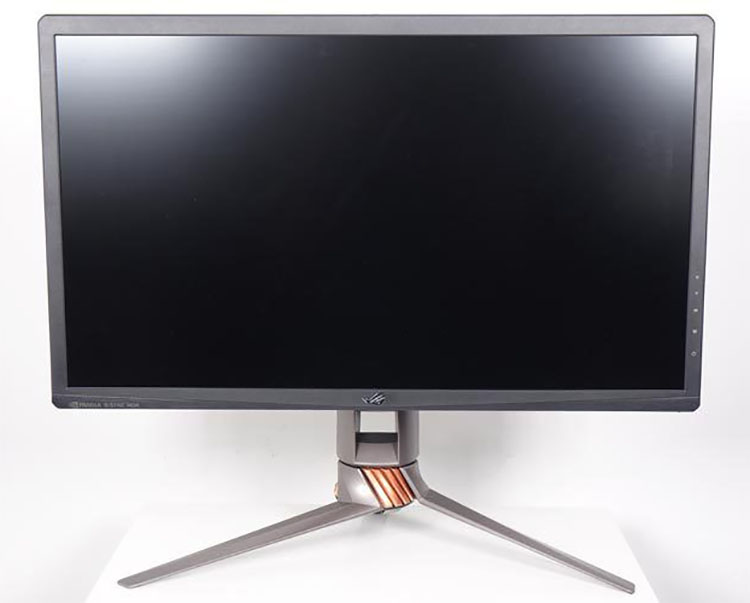
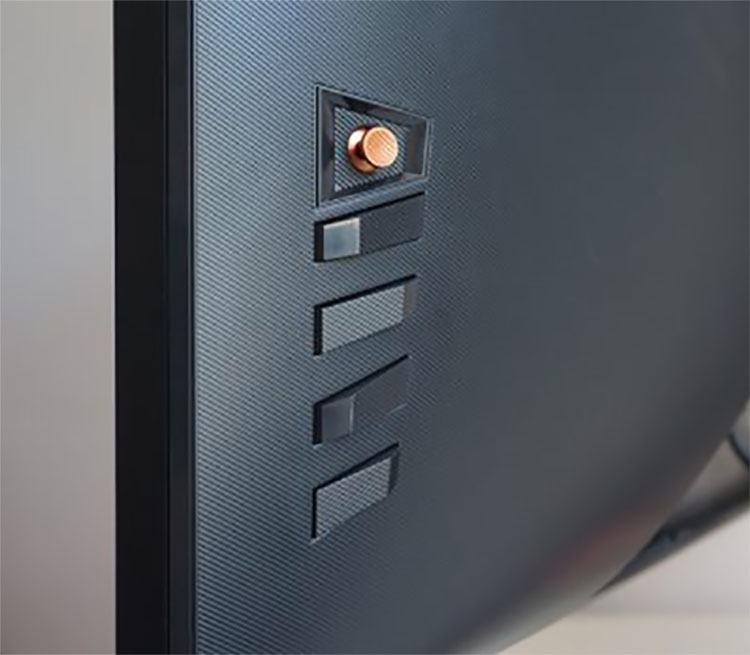
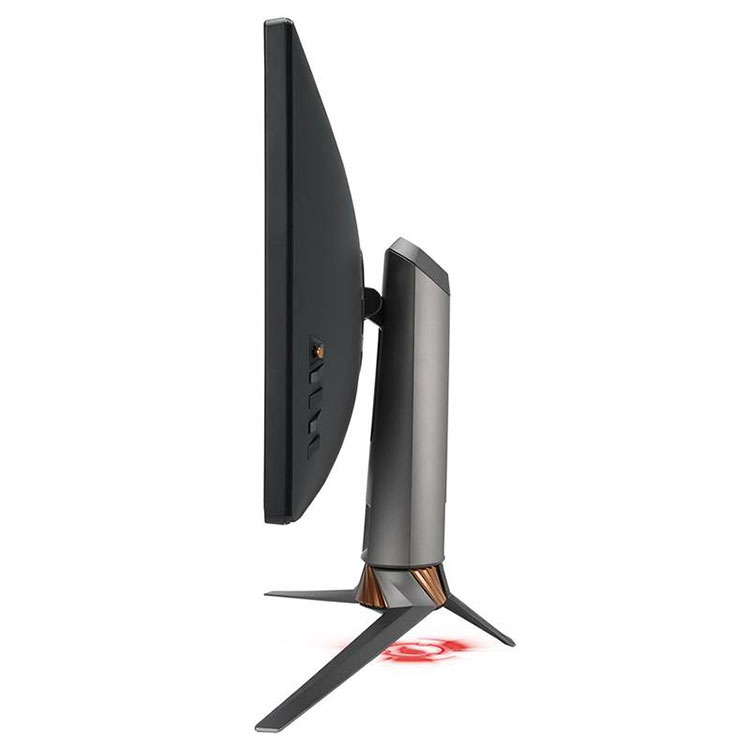
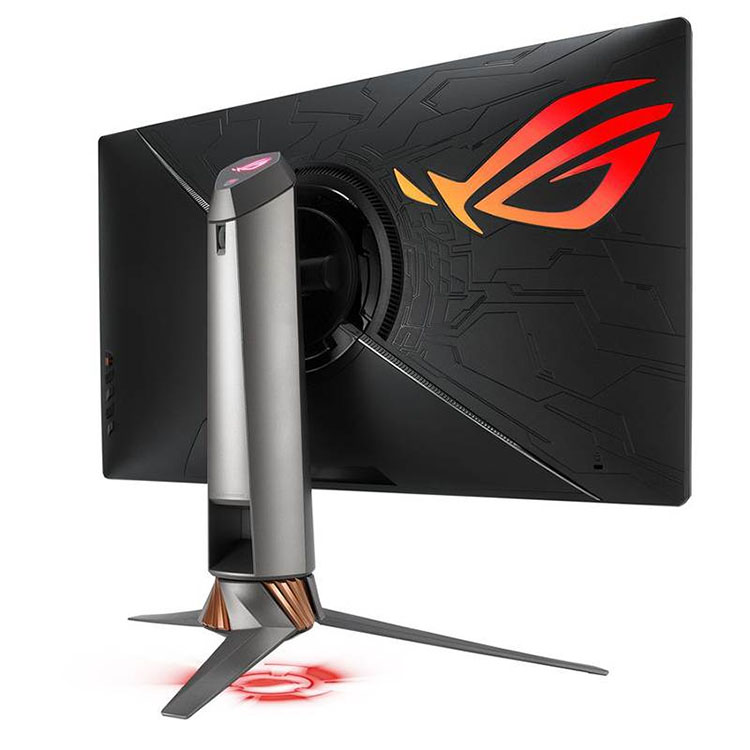
From the front, you’ll never guess the PG27UQ is different from any other Asus ROG monitor. The bezel is fairly wide at 20mm on the top and bottom and 16mm on the sides. The anti-glare layer is set back a bit and rejects reflections effectively without causing resolution-robbing grain in the image. The picture is super-clear, stunning in fact, thanks to a tight 163ppi pixel density and the amazing contrast possible when the Variable Backlight feature is on (more on that on page four).
You control the on-screen display (OSD) via three keys and a joystick, which brings up the full OSD if pressed. The fourth button in the photo is a power toggle, and yes, you might push it accidentally sometimes. Here’s a suggestion to Asus and other vendors taking this approach: provide an on-screen confirmation so the user must press the power key a second time to turn off the monitor. Many projectors do this, and it makes sense.
Styling is slightly subdued when compared to other ROG screens, but molded textures are there along with some nice lighting effects. The base projects a pattern onto your desktop, and there is an ROG logo around back that is also backlit. You can control the effects in the OSD and even sync them to other ROG hardware components. There are many options that change colors and brightness with breathing and flashing accents. Or, you can turn the whole thing off if you wish. Meanwhile, the power LED light glows white in normal mode and red when G-Sync is working.
Stand adjustments are firm and precise and include 4.7” inches of height, 45° swivel in each direction, 25° back tilt and 5° forward. You also get a 90° portrait mode.
MORE: Best Gaming Monitors
MORE: How We Test Monitors
MORE: All Monitor Content

Christian Eberle is a Contributing Editor for Tom's Hardware US. He's a veteran reviewer of A/V equipment, specializing in monitors. Christian began his obsession with tech when he built his first PC in 1991, a 286 running DOS 3.0 at a blazing 12MHz. In 2006, he undertook training from the Imaging Science Foundation in video calibration and testing and thus started a passion for precise imaging that persists to this day. He is also a professional musician with a degree from the New England Conservatory as a classical bassoonist which he used to good effect as a performer with the West Point Army Band from 1987 to 2013. He enjoys watching movies and listening to high-end audio in his custom-built home theater and can be seen riding trails near his home on a race-ready ICE VTX recumbent trike. Christian enjoys the endless summer in Florida where he lives with his wife and Chihuahua and plays with orchestras around the state.
-
mlee 2500 Won't catch me buying a monitor with a fan inside. I don't care how great it is otherwise. Not too mention 4K at 27" is kind of a pointless waste of the GPU resources you use to drive it. Even at 28" I find my XB280HK too small for most games at 4K...it just makes all the hours that game developers and artists put into their product become pointless when the details are too small to notice.Reply
I've come to the conclusion that 30" is probably the sweet spot of not extending too far beyond your peripheral vision while still being large enough to make 4K worthwhile (I had a 31" LG and it was *too* big, IMHO). Of course this all assumes a rational 16:9 aspect ration. Don't even get me started on these super wide models with a paltry 1440 vertical. Seems like a neck injury waiting to happen. -
milkod2001 This is something i was waiting for ages. Just one thing. I'm not 13years old any more, wish i was :). I don't need that stupid holographic or RGB lighting at the back. Just regular adjustable stand. I also don't need HDR, it's immature gimmick at the moment. I also want 32'' 4k version. 27''4k is a joke. Also price should be more down to earth $1200-1500. Gonna wait a little bit more i guess.Reply -
milkod2001 Go ahead and read reviews of actual owners on newegg. There is a loud fan included. This is not acceptable at this price.Reply -
moogleslam @Joe Black - I wouldn't call that the best thing about it, but sure, there isn't much need for a 16:9 27" to be curved. Not sure if you're against curved in general, but there's absolutely a place for it. a 21:9 34" or a 32:9 49" absolutely has to be curved.Reply

